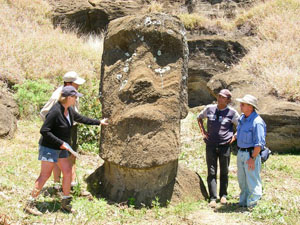January 16, 2009
Efforts will protect and preserve Easter Island’s Rapa Nui Moai statues

Boston – The Archaeological Institute of America (AIA), North America’s oldest and largest organization devoted to the world of archaeology, has selected the monolithic sculptures (moai) of Easter Island (Rapa Nui), Chile, and national park as its second site preservation project. With a $94,000 grant to the Easter Island Statue Project from the organization’s AIA Site Preservation Task Force, the Project will develop stone preservation techniques to arrest the rapid deterioration of these statues as a result of the fragile nature of their volcanic stone, climate change, and tourism. The Easter Island Statue Project is directed by UCLA archaeologist Jo Anne Van Tilburg and co-directed by Cristín Arévalo Pakarati.
“The grant will jumpstart our efforts to preserve this remarkable cultural resource for future Rapanui generations and the world at large,” said Van Tilburg. “The fragility of the stone, coupled with the fact that Rano Raraku is a major tourist destination, creates an urgent conservation imperative. We thank the AIA for its assistance in this monumental task.” Monica Bahamondez, a conservation specialist with the Chilean State National Center for Conservation and Restoration, noted “The statues are deteriorating more rapidly every day. This grant will jump start and complement our conservation efforts”.
The grant was awarded in a ceremony in the office of Rapa Nui Mayor Petero Edmonds, who thanked the AIA. According to Edmonds, “for projects to be successful they require the empowering and strong involvement of the local community. This Project is a wonderful example of the sort of local, national and international cooperation required.”
The project will initially focus upon the conservation of two statues in the Rano Raraku interior quarry, which Van Tilburg and her team have recently mapped using the latest in digital technology. The source of nearly all of the island’s 1,000 statues, Rano Raraku is a striking landmark still filled with more than 400 statues in all stages of completion. The knowledge gained in the Rano Raraku conservation study will then be employed to preserve the other numerous statues located throughout the island.
“Our selection of the Easter Island Statue Project and our first preservation project, restoring and preserving the magnificent Temple of Athena in Turkey, which is well underway, exemplify the model of preservation the AIA seeks to promote,” said University of Pennsylvania archaeologist and AIA Task Force Co-chairman Larry Coben. “Not only will this initiative preserve these cultural icons using the highest technical standards, but it will also demonstrate that successful and sustainable preservation requires the empowerment of, and economic development for, local communities.”
Both the Easter Island and Temple of Athena projects are part of the AIA’s long-term conservation strategy to combat the loss of the world’s priceless cultural heritage. The AIA Site Preservation Task Force, a group of volunteers consisting of archaeologists and business, economic, development and international relations experts, was formed in 2008 in response to the rapidly accelerating destruction of ancient monuments and sites due to war, looting, extreme weather, alternative economic uses and neglect. In addition to sustainable preservation, the Task Force provides resources and education to empower and encourage economic development in local communities, and promotes preservation and conservation throughout the world.
Notifications